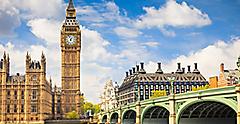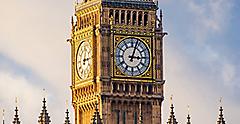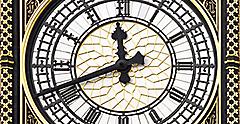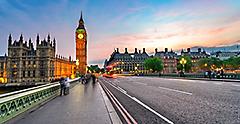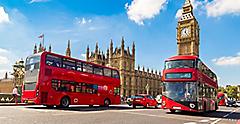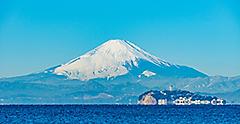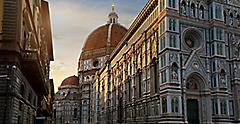By Hayley Simpson | Published on January 4, 2024
Big Ben's Big Beginning, What Is Its Real Name?
On sightseeing tours in London, a question that gets asked often is, "What is the real name of Big Ben?" Big Ben's real name is Elizabeth Tower, also referred to as the Clock Tower though let's set the record straight. While everyone calls the clock tower Big Ben, the nickname belongs specifically to its nearly 14-ton bell, also known as the Great Bell. It lives up to its name though, as the hammer inside the bell weighs over 400 pounds alone. So, you'll technically find Big Ben inside the Elizabeth Tower. Both were built in 1859, and while the tower has undergone significant renovation recently, it's the same historic bell that chimes across the northern bank of the River Thames today. Its companions include four smaller quarter bells.
Elizabeth Tower is a masterpiece and stalwart of the London skyline, standing 316 feet tall on the northern side of the Houses of Parliament. Formally known as the Palace of Westminster, this serves as the meeting place for both the House of Commons and the House of Lords and is located in London's bustling Westminster district.
The clock tower was designed by Augustus Pugin in the neo-Gothic Revival architectural style. There are 334 steps to reach the belfry and 399 steps to the top of the tower. It has four massive clock faces, with 14-foot-long minute hands that weigh approximately 220 pounds each. Each clock face consists of 312 sections of opal glass that get cleaned every five years. They're also lit by 28 85-watt energy-efficient bulbs that can last 60,000 hours (or seven years).
The origin of Big Ben's name is actually unknown, although there are two main theories. The first is that it was named in honor of Sir Benjamin Hall (nicknamed Big Ben), London's first commissioner of Public Works. He was the man in charge of the Houses of Parliament's construction. His name was inscribed on the bell when it was cast, so this is perhaps the most likely theory. However, the alternative is that it was named after another Big Ben: English heavyweight boxing champion at the time, Benjamin Caunt. Which theory do you prefer?
Fun Facts About Big Ben In Elizabeth Tower
Now that you've become acquainted, here are some of the most fun facts about Big Ben. Firstly, since 1859 the bell has rarely stopped ringing. Even when bombs were raining down on London during World War II and destroyed the neighboring Commons Chamber, Elizabeth Tower survived, and Big Ben continued to strike every hour. However, during this time the clock faces were dimmed to not attract attention.
Here are two unique scenarios when Big Ben's timekeeping wasn't at its peak accuracy. The first was when a flock of birds rested on the minute hand in 1944, slowing the clocks down. The second was on New Year's Eve in 1962 when Big Ben chimed late because snow and ice weighed down the hands.
When it was built, the tower's clock was the world's largest and most accurate four-faced striking and chiming clock. Big Ben's timekeeping is precisely controlled by a small stack of pre-decimal penny coins placed on a huge pendulum. Adding or removing a penny changes the clock's speed by 0.4 seconds per day, so the tower expertly keeps time within a few seconds every week. There's actually a role called the Keeper of the Clock, and they're responsible for keeping time and hand winding the clock three times a week.
The clock tower has many special features, including 52 shields representing different historic moments. This includes the national emblems of the four nations that encompass the United Kingdom: a red and white rose for England, a thistle for Scotland, a shamrock for Northern Ireland, and a leek for Wales. There's also a pomegranate for Catherine of Aragon, the first wife of Henry VIII.
Finally, you wouldn't be out of line to refer to it as Britain's Leaning Tower of Pisa. While its slight tilt to the northwest isn't as impressive (only 0.26 degrees), it was first discovered during the planning of the Jubilee Line extension under the Houses of Parliament.
Facts About The Royal Family And Big Ben's Royal Connection
Big Ben has such a long history, it should be no surprise that many Big Ben facts overlap with facts about the royal family. These two significant parts of British history actually have a lot in common. Big Ben has chimed through the reigns of six monarchs: Queen Victoria, King Edward VII, King George V, King Edward VIII, King George VI, and Queen Elizabeth II. That said, how did the royal family start?
Perhaps the most fascinating British royal family fact is that the family line can be traced back more than 1,200 years. In fact, it all began with the Norman invasion in 1066. William the Conqueror landed in England, and the rest was history.
For nearly 500 years, the Palace of Westminster was London's principal royal residence. It began hosting the Royal Council following the Norman conquest of 1066, and in 1265 the first elected English government took up residence in its hallowed halls. Unfortunately, two fires in 1512 and 1834 destroyed the palace, but it was after the latter fire that plans for the current Houses of Parliament and Elizabeth Tower took shape. Big Ben chimed for the first time on May 31, 1859, and has been ringing ever since.
In June 2012, the House of Commons announced that the clock tower housing Big Ben would be renamed Elizabeth Tower in honor of Queen Elizabeth II's Diamond Jubilee. Beforehand, it had the very original name of the Clock Tower.
The name change mirrors a similar tribute made to Queen Victoria, the only other monarch to celebrate a Diamond Jubilee. The Houses of Parliament renamed the King's Tower in its southwest corner the Victoria Tower in the 19th century. There's another homage to Queen Victoria (Queen Elizabeth II's great-great-grandmother) in the form of a Latin motto under a clock face (DOMINE SALVAM FAC REGINAM NOSTRAM VICTORIAM PRIMAM), which translates to "O Lord, keep safe our Queen Victoria the First."
At the top of Elizabeth Tower, you'll find the Ayrton Light, a green lantern-like structure installed in 1885. It shines whenever either House of Parliament is in session. Named after politician Acton Smee Ayrton, Queen Victoria requested its installation, so she could see whether parliament was sitting after dark from Buckingham Palace, less than a mile away. Who needed phones when you had the Ayrton Light instead?
Its Roots As A British Cultural Icon
There aren't many London landmarks as culturally or historically iconic as Big Ben. This significance was recognized when it became a UNESCO World Heritage Site in 1987. It's also one of the most prominent symbols of the United Kingdom and of parliamentary democracy, thanks to its location next to the Houses of Parliament.
Named London's most iconic film location, it's been featured in nearly 20 Disney films. This includes "Peter Pan," when Peter and the Darling siblings take a short break on one of the clock's minute hands before flying onto Neverland. The BBC also first broadcast the symbolic chimes on December 31, 1923, which has since become a tradition. In fact, Big Ben's chimes echo between the main bulletins of most major U.K. news broadcasts and are heard by millions of U.K. residents daily.
Another feather in its cap as a British cultural icon is the fact that it's the main focus of London's annual New Year's Eve celebrations, alongside the London Eye on the opposite side of the River Thames. Every year, Big Ben's toll is joined by fireworks, light installations, and live music performances. It's a symbol of unity among both local residents and people around the world.
Visiting Big Ben, Getting Up Close And Personal
Since 2017, Elizabeth Tower and Big Ben have undergone the biggest conservation project in their history. While public tours are yet to recommence, note that in the past they were only open to U.K. residents for security reasons and they sold out up to six months in advance. The 90-minute guided tours took you through the clock tower and the Houses of Parliament where you saw both Houses, the Royal Gallery, and the Queen's Robing Room.
As for now, you can watch debates in both the House of Lords and the House of Commons for free when you visit England. You can also visit Westminster Hall and the Jewel Tower, which are the oldest remaining features of the original palace. The Houses of Parliament have over 1000 rooms, 11 courtyards, and several bars and restaurants. So, you can also do as the royals do and enjoy a quintessentially British afternoon tea by the Thames from the site of the first royal residence.
Get Royal Deals, Sign Up Today

Getting There
Explore Our Most Affordable Itineraries
Check out Big Ben in all its glory when you cruise to the British Isles.
Related Articles

The Best Time to Visit Bermuda | Royal Caribbean Cruises
READ MORE

Girls and guys weekend trip ideas: How to plan a cruise getaway | Royal Caribbean Cruises
READ MORE

Can You Take Days Off Without PTO? Here's What You Need to Know | Royal Caribbean Cruises
READ MORE

[Infographic] What to Drink at Perfect Day at CocoCay
READ MORE

